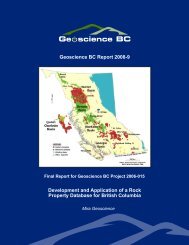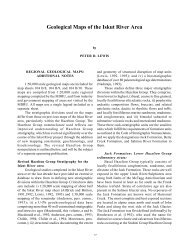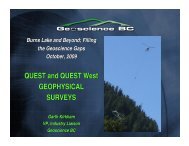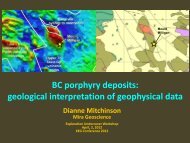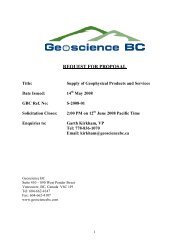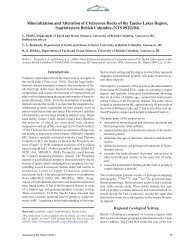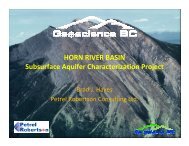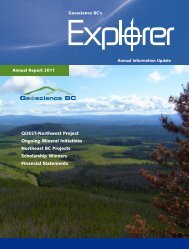Report - Geoscience BC
Report - Geoscience BC
Report - Geoscience BC
Create successful ePaper yourself
Turn your PDF publications into a flip-book with our unique Google optimized e-Paper software.
Magnetic Susceptibility<br />
Magnetic susceptibility was measured on hand samples in the lab using a GF Instruments<br />
SM-20 pocket magnetic susceptibility meter, with a sensitivity of 10 -6 SI volume units. The<br />
measurement coil has a 5 cm diameter, and ~90% of the measured response comes from the top 2<br />
cm of the sample. We investigated the effect of small sample size on the measurements and<br />
found that samples more than 3 cm thick allow accurate magnetic susceptibility determinations.<br />
Usually 3 measurements were taken on different surfaces of the sample and the average is<br />
reported. The standard deviation of the 3 measurements is typically 10% due to spatial variations<br />
of magnetite concentration. Susceptibility measurements on cores were measured with a<br />
Sapphire SI2B susceptibility meter, accurate to 10 -7 SI. These measurements were used in<br />
preference to the SM-20 measurements.<br />
Table 2. Maximum and minimum values of magnetic susceptibility for the Nechako Basin<br />
sample suite.<br />
Maximum Value<br />
Minimum Value<br />
Magnetic Susceptibility (SI) 5.40 x 10 -2 2.79 x 10 -5<br />
Magnetic remanence and Koenigsberger ratio<br />
Magnetic remanence was measured using an AGICO JR5-A spinner magnetometer<br />
(sensitivity 10 -5 A/m). The full vector was measured, but only the total vector magnitude of the<br />
remanence is reported in the database.<br />
The Koenigsberger ratio (K N ) compares the relative strength of the natural remanent<br />
magnetization (NRM) to the induced magnetism in the geomagnetic field: K N = NRM / ( H 0 χ 0 ),<br />
where χ 0 is the magnetic susceptibility and the geomagnetic field strength (H 0 ) is approximated<br />
as a constant 40 A/m (or µ 0 H 0 = 50 µT = 50000 γ). When K N is above 1, then magnetic anomaly<br />
interpretation will be incorrect if magnetic remanence is not taken into consideration.<br />
Table 3. Maximum and minimum values of magnetic remanence and Koenigsberger ratio for the<br />
Nechako Basin.<br />
Maximum Value<br />
Minimum Value<br />
NRM (A/m) 27.7 2.57 x 10 -4<br />
K N 45.4 9.99 x 10 -3






